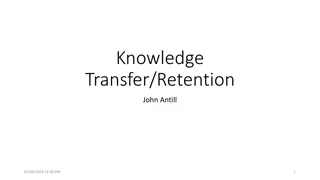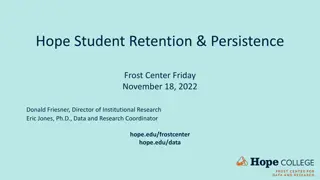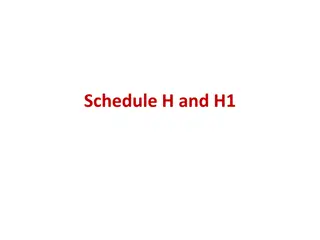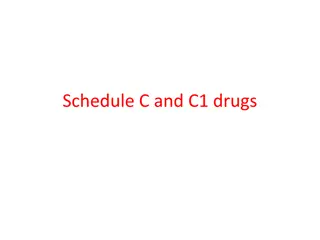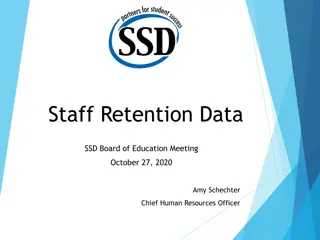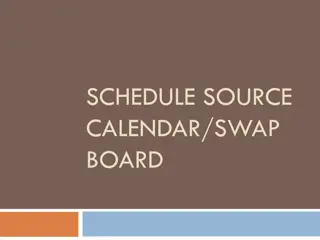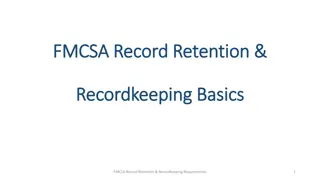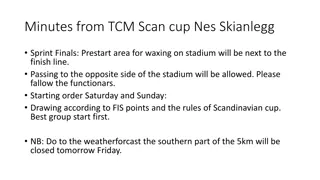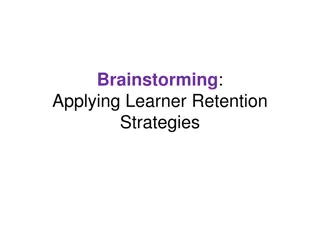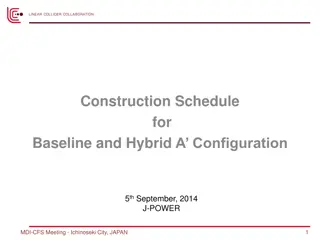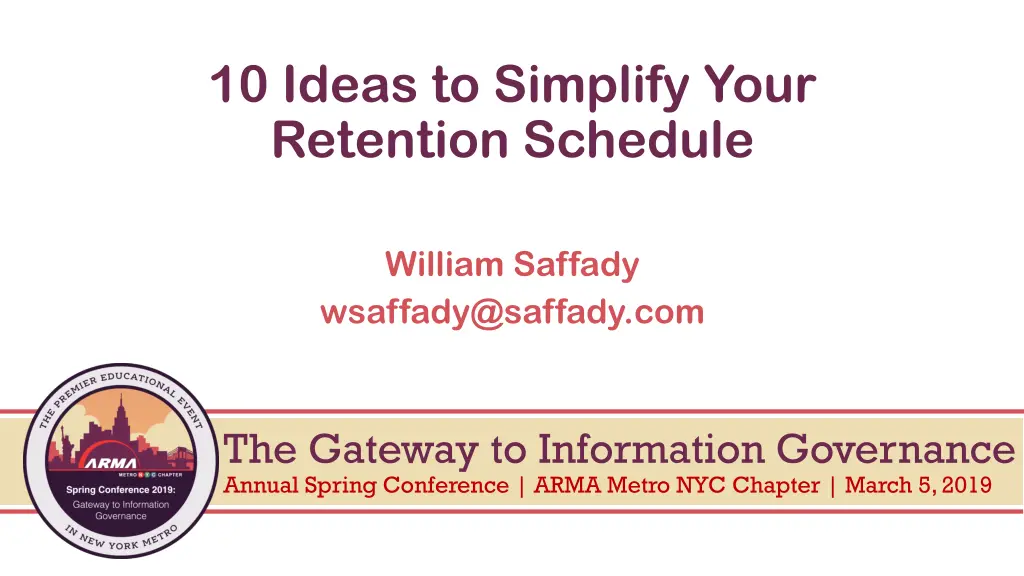
Streamlining Retention Schedules for Efficient Records Management
Learn valuable insights on simplifying and optimizing retention schedules to enhance records management efficiency. Discover tips for setting clear objectives, defining scope, and aggregating record series effectively. Overcome common challenges such as complexity and inconsistency to ensure a smooth retention process.
Download Presentation

Please find below an Image/Link to download the presentation.
The content on the website is provided AS IS for your information and personal use only. It may not be sold, licensed, or shared on other websites without obtaining consent from the author. If you encounter any issues during the download, it is possible that the publisher has removed the file from their server.
You are allowed to download the files provided on this website for personal or commercial use, subject to the condition that they are used lawfully. All files are the property of their respective owners.
The content on the website is provided AS IS for your information and personal use only. It may not be sold, licensed, or shared on other websites without obtaining consent from the author.
E N D
Presentation Transcript
10 Ideas to Simplify Your Retention Schedule William Saffady wsaffady@saffady.com The Gateway to Information Governance Annual Spring Conference | ARMA Metro NYC Chapter | March 5, 2019
Overview Record periods are based on information lifecycle concept Essential characteristics Must be systematically developed in regular course of business Must comply with applicable laws and regulations Must be reasonable Retention criteria Legal requirements Operational need Scholarly value 2
Problems with Retention Schedules Difficult and time-consuming to create Too long and overly complicated Incomplete; some unscheduled records Inconsistent retention periods for similar records Difficult to understand and apply Weak user acceptance; not consistently implemented Time-consuming to review and update 3
#1 Determine the objective Elimination of obsolete records The historical basis for professional records management Will favor shortest possible retention periods for non-permanent records Addresses storage costs; secondarily discovery costs, privacy issues Preservation of relevant records Compatible with view of information as an asset Will err on the side of keeping records longer for operational reasons or uncertainties about compliance requirements May be favored by departmental custodians Impact of electronic recordkeeping 4
#2 Determine the scope Clear definition of a record Will some recorded information be omitted from retention initiative? Identify non-records Transitory documents Specific types and formats for example: email, databases Will some functions / departments be omitted from the schedule? How will duplicate records be handled? 5
#3 Aggregate record series The big bucket approach groups records in broad categories Combines record series to reduce granularity Granular example: ACC001 General ledger 10 years ACC002 Subsidiary ledgers and journals 7 years ACC003 Balance sheets 7 years ACC004 Profit and loss statements 7 years ACC005 Bank account statements 7 years ACC006 Canceled checks 7 years ACC007 Fiscal audit records 10 years 6
#3 Aggregate record series Or even more granular: General Accounting GAC001 GAC002 GAC003 GAC004 GAC005 General ledger 10 years Chart of accounts 10 years Cash management ledger 7 years Fixed asset ledger 7 years Trial balances 7 years Banking BNK001 BNK002 BNK003 BNK004 BNK005 Bank account statements 7 years Canceled checks 7 years Voided checks 7 years Wire transfers 7 years Deposit slips 7 years Fiscal Audit AUD001 AUD002 AUD003 AUD004 AUD005 Audit schedules 7 years External audit reports 10 years Internal audit reports 10 years Internal audit work papers 10 years Audit responses 10 years 7
#3 Aggregate record series Big bucket consolidation: ACC Accounting Records 10 years Description: Records related to general accounting, banking, and fiscal audits Examples: Accounting ledgers Bank account statements Canceled checks Audit reports and work papers 8
#3 Aggregate record series Not a simple pruning of obsolete and redundant series Systematic consolidation based on analysis of business operations and activities Does not eliminate record series concept, just fewer of them Advantage: Shorter schedule with fewer choices is easier to understand and apply Concerns: Possible over-retention, crosswalk needed from old schedule, what about older records in storage? 9
#4 Fewer retention periods Standardize on a few retention choices to simplify schedule development and implementation 3 years for records of short-term value 10 years (or possibly 7 years) for records with medium-term operational value or legal retention requirement Indefinite retention for records that need to be kept longer with re-evaluation after specified period of time but may need another choice between 10 and 30 years Permanent designation reserved for records with scholarly value 10
#5 Flexible retention periods Also described as retention bands Specifies range of acceptable retention periods for a given record series -- for example: 7 to 10 years Retention period expressed as minimum and maximum Record custodians select a retention period within the specified range May encourage but not mandate the minimum period Advantage: Adaptable to variety of situations; giving departments some discretion may encourage compliance 11
#6 Minimize event-driven retention Definition Retention trigger is an event beyond the current year Retention period begins at undetermined future time Examples: case files, project files, personnel files, student files, patient files Issues Trigger event may occur in distant future or not at all Difficult to implement with big bucket schedules Incompatible with automated record retention Alternative may involve very long retention period that transcends future event for entire record series 12
#7 Handling Duplicate Records Information copies and not backup copies Duplicate records often outnumber official copies Identifying official copies In departmental schedules: limited to official copies More complicated in functional schedules Retention options for duplicate records Enumerate and specify retention periods for all copies Discard at any time but do not keep longer than official copy Maximum retention period for all duplicate records 13
#8 Use Policies for Some Records Schedule is a listing of record series Certain records are associated with multiple categories Certain records require more detailed explanation and instructions than a schedule can provide Examples Duplicate records Documents of transitory value: notes, outlines, etc. Email File shares Older unscheduled records Information that should never be kept 14
#9 Consider Uniform Time Periods Default retention period for records that cannot be individually examined Examples Email File shares Records associated with defunct operations Records obtained from acquired entities Unscheduled records in offsite storage and elsewhere Duplicate records Documents of transitory value Exceptions limited to unusual circumstances 15
#10 Create a General Schedule For records associated with multiple departments or business functions Examples Policies and procedures Periodic and ad hoc reports about specific matters Committee records Project records Budget preparation records (departmental) Subject files Appointment calendars Travel records Lists, logs, databases created for administrative convenience 16




